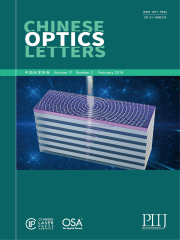 View fulltext
View fulltext
The emergence of new materials can push scientific development and even lead to a new industrial revolution. The discovery of graphene has attracted more and more attention from society due to their excellent optics and electricity properties. Graphene has been widely used in optoelectronic devices, such as an optical modulator, polarizer, photoelectric detector, and ultrafast laser. In addition, there is a remarkable transition towards other nanomaterials in recent years. Apart from topological insulators (TIs), transition metal dichalcogenides (TMDs), and monoelemental two-dimensional (2D) materials, composites and heterogenous layered materials are also worthy of mention.
Graphene has attracted great interest in optoelectronics, owing to its high carrier mobility and broadband absorption. However, a graphene photodetector exhibits low photoresponsivity because of its weak light absorption. In this work, we designed a graphene/MoSe2 heterostructure photodetector, which exhibits photoresponse ranging from visible to near infrared and an ultrahigh photoresponsivity up to 1.3×104 A·W 1 at 550 nm. The electron–hole pairs are excited in a few-layered MoSe2 and separated by the built-in electric field. A large number of electrons shift to graphene, while the holes remain in the MoSe2, which creates a photogating effect.
Two-dimensional (2D) materials have attracted intense attention in photonics and optoelectronics for their excellent nonlinear characteristics and are applied for the generation of laser pulses. Here, an active–passive Nd:GdVO41.3 μm laser is realized by using an acousto-optic modulator and gold nanobipyramids absorber. The pulse width of 150.5 ns is obtained in the doubly Q-switched laser. The compression ratio and enhancement time are 82.6% and 16. The doubly Q-switched technology compresses the pulse width, improves the peak power, and stabilizes the pulse, illustrating that double modulation technology opens the door of controllable ultrafast lasers based on 2D materials.
We demonstrate an all-fiber Q-switched cylindrical vector laser based on a black phosphorus saturable absorber and a transverse mode converter. The saturable absorber is prepared by incorporating the polyvinyl alcohol with anti-oxidized black phosphorus nanosheets exfoliated in aqueous poly(dimethyldiallyl ammonium chloride) solution. The mode converter is composed of a tapered two-mode fiber and a single-mode fiber, and it can excite switchable azimuthally and radially polarized beams by modulating the input polarization. By enhancing the pump power from 64.68 to 174.82 mW, the repetition rate of the Q-switched azimuthally/radially polarized laser enlarges from 16.72/19.25 to 30.71/37.82 kHz.
Broadband transient reflectivity traces were measured for Bi2Se3 thin films with various substrates via a 400 nm pump–white-light-probe setup. We have verified the existence of a second Dirac surface state in Bi2Se3 and qualitatively located it by properly analyzing the traces acquired at different probe wavelengths. Referring to the band structure of Bi2Se3, the relaxation mechanisms for photo-excited electrons with different energies are also revealed and studied. Our results show a second rise of the transient reflection signal at the time scale of several picoseconds. The types of substrate can also significantly affect the dynamics of the rising signal. This phenomenon is attributed to the effect of lattice heating and coherent phonon processes. The mechanism study in this work will benefit the fabrication of high-performance photonic devices based on topological insulators.
Compared with the extensively studied MoS2 and WS2, WTe2 owns a smaller bandgap, which is applicable to a near-infrared system in photodetectors, communications, and ultrafast optics. In this work, the WTe2 saturable absorber (SA) with the tapered fiber structure is prepared by the magnetron-sputtering technology, which enables the prepared SA to be low in cost and have strong nonlinearity. The modulation depth of the prepared WTe2 SA is measured as 31.06%. The Q-switched fiber laser operating at 1.5 μm is successfully investigated by incorporating the proposed SA into the prepared ring cavity. To the best of our knowledge, this is the first attempt of WTe2 in the Q-switched fiber laser at 1.5 μm.
In this Letter, we have shown that a giant Goos–H nchen shift of a light beam reflected at terahertz frequencies can be achieved by using a composite structure, where monolayer graphene is coated on one-dimensional photonic crystals separated by a dielectric slab. This giant Goos–H nchen shift originates from the enhancement of the electrical field, owing to the excitation of optical Tamm states at the interface between the graphene and one-dimensional photonic crystal. It is shown that the Goos–H nchen shift in this structure can be significantly enlarged negatively and can be switched from negative to positive due to the tunability of graphene’s conductivity. Moreover, the Goos–H nchen shift of the proposed structure is sensitive to the relaxation time of graphene and the thickness of the top layer, making this structure a good candidate for a dynamic tunable optical shift device in the terahertz regime.
The optical Tamm state (OTS), which exists generally at the interface between metal and a dielectric Bragg mirror, has been studied extensively in the visible and near infrared spectra. Nevertheless, OTS in the terahertz (THz) region normally receives far less attention. In this Letter, we demonstrate the physical mechanism of OTS at the interface between graphene and a dielectric Bragg mirror in the THz frequency band by applying the transfer matrix method and dispersion characteristics. Based on such mechanisms, we propose an efficient method that can precisely generate and control OTS at a desired angle and frequency. Moreover, we show that the OTS is dependent on the optical conductivity of graphene, making the graphene–dielectric-Bragg-mirror a good candidate for dynamic tunable OTS device in the THz frequency range.
A single output Q-switched Nd:GdVO4 laser with a reflective graphene oxide (GO) saturable absorber was demonstrated. The shortest pulse duration in the Q-switched laser is 115 ns, and the output power ranges from 1.23 W at 1.71 MHz to 2.11 W at 2.50 MHz when the pump power rises from 7.40 to 10.90 W with the utilization of GO Langmuir–Blodgett (LB) films based on the convenient and low-cost LB technique. To the best of our knowledge, it is the highest output power in a Q-switched laser with a GO saturable absorber.
The electronic and optical properties of the ZrS2/SnS2 van der Waals heterostructure have been investigated. We find out that the formed heterostructure has an intrinsic type-I band alignment. Moreover, the characteristics of optical absorption in the heterostructure can be enhanced to the amount of 106 in the ultraviolet light region. In addition, the tuning electronic properties of ZrS2/SnS2 heterostructure are very interesting, due to the transitions from type-I to type-II band alignment that can occur by applying an external electric field. These results suggest that the atomically thin materials ZrS2/SnS2 heterostructure will be utilized for flexible optoelectronic applications.
Solid-state sources of single-photon emitters are highly desired for scalable quantum photonic applications, such as quantum communication, optical quantum information processing, and metrology. In the past year, great strides have been made in the characterization of single defects in wide-bandgap materials, such as silicon carbide and diamond, as well as single molecules, quantum dots, and carbon nanotubes. More recently, single-photon emitters in layered van der Waals materials attracted tremendous attention, because the two-dimensional (2D) lattice allows for high photon extraction efficiency and easy integration into photonic circuits. In this review, we discuss recent advances in mastering single-photon emitters in 2D materials, electrical generation pathways, detuning, and resonator coupling towards use as quantum light sources. Finally, we discuss the remaining challenges and the outlooks for layered material-based quantum photonic sources.
We have demonstrated an all-fiber passively mode locked erbium-doped fiber laser (EDFL) based on graphene–polyvinyl-alcohol film. By watchfully adjusting the polarization controller, two different polarization attractors, including polarization locked vector solitons and a circular attractor, can be observed. This is first time, to the best of our knowledge, to explore the dynamics polarization attractors exhibited by a vector soliton generated from an EDFL based on graphene.
Graphene and other extraordinary two-dimensional materials together with recent advances in optical modulators have set the foundations for the widespread applications of next-generation optoelectronic devices. In this work, we report on the high-performance fundamentally mode-locked waveguide laser modulated by chemical-vapor-deposition-grown WSe2 as a saturable absorber. By incorporating a WSe2 sample into a monolithic Nd:YVO4 waveguide platform, 6.526 GHz picosecond pulsed laser generation has been achieved at the wavelength of 1 μm with pulse duration of 47 ps.
Exciton-polaritons offer an exceptional platform for future photoelectronic and quantum information applications. The influence of the optical Stark effect on exciton-polaritons in a microcavity embodied with a monolayer WS2 is studied. A polarization dependent model is proposed to study the change of strongly coupled excitons and photons in a WS2 microcavity. It is revealed through both steady and dynamical states analysis that an outside optical Stark pulse can effectively vary the polariton characteristics, such as dispersion, exciton, and photon fractions, through blue shifting of excitonic resonance. Thus, the analysis and control of exciton-polaritons in a WS2 microcavity via a spin-selective trigger could be achievable.














